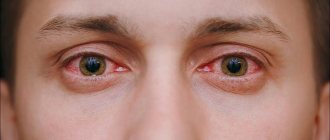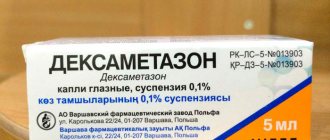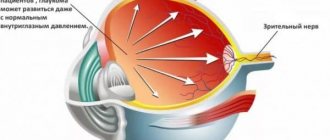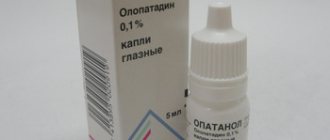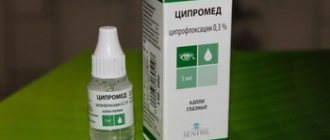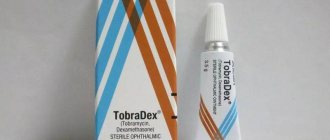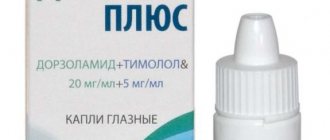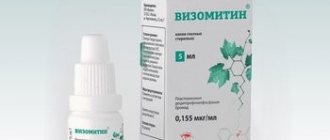Indications for use
Ophthalmologists use Tropicamide to diagnose and treat eye diseases. For diagnostic purposes, it is advisable to use the drug if there is a need to check the condition of the lens, examine the fundus of the eye, and monitor the degree of refraction of the eyes.
Also, with the help of drops, conservative therapy of inflammatory diseases such as keratitis, uevitis, and iridocyclitis is carried out. Tropicamide is used in surgeries on the lens, vitreous body, retina, cataract removal and laser coagulation. After surgery, the drug is prescribed to prevent synechiae.
Composition, dosage form
The main active component of Tropicamide ophthalmic drops is the substance of the same name, tropicamide, which has the properties of M-anticholinergics. There are 5 mg of active substance per 1 ml of drops.
The composition also contains additional elements:
- sodium chloride;
- purified water;
- benzalkonium chloride;
- disodium salt of ethylenediaminetetraacetic acid;
- hydrochloric acid.
Tropicamide eye drops are a colorless and transparent liquid without a distinct odor. The medicinal composition is packaged in polyethylene tubes, at the end of which there is a built-in dropper designed for precise dosing of the medication. The concentration of the active substance in one 5 ml bottle can be 0.5 or 1%. The original cardboard box contains one bottle and instructions with a detailed description of the drops.
The drug is produced by the pharmaceutical corporation "WARSAW PHARMACEUTICAL WORK POLFA, SA" at factories located in Poland.
Dosage
The dosages of Tropicamide eye drops differ due to the difference in the concentration of the active substance. To obtain the effect, 2 drops of 0.5% and 1 drop of 1% solution are enough. If you need to prolong the effect of mydriasis, repeat instillation after 10 minutes.
When using a solution of tropicamide 0.5%, observe the following dosages:
- for ophthalmoscopy – 2-3 drops;
- refraction analysis – 6 instillations every 6-12 minutes;
- therapy of eye diseases - the drug is dripped 6 times a day.
Dosages of 1% tropicamide solution
A lasting effect of cycloplegia is achieved by instilling 1-2 drops. If necessary, repeat instillation after 5 minutes. If the patient has not been examined after 25 minutes, mydriasis is prolonged by instilling 1 drop of the drug.
To create paralysis of the accommodative muscles, the solution must be administered 6 times, 1 drop every 6-12 minutes. After instilling 6 drops, refraction testing is available for 25-50 minutes.
Pharmacodynamics and pharmacokinetics
What is Tropicamide?
Tropicamide is a drug that suppresses the m-cholinergic receptors of the ciliary muscle and the sphincter muscle of the iris, quickly and for a short time enlarges the pupil and paralyzes the ability to accommodate.
Pharmacodynamics
The increase in pupil diameter begins 6-9 minutes after a single instillation of the solution into the conjunctival sac, the maximum effect develops after 17-20 minutes and lasts for 60 minutes when instilling a 0.5% solution and 120 minutes when instilling a 1% solution. After 5 hours the effect disappears completely.
Maximum paralysis of the ability to accommodate after administration of 1% Tropicamide twice with a break of 5 minutes is recorded after approximately 25 minutes and lasts up to half an hour. Restoration of physiological functions occurs in this case after 3 hours.
Pharmacokinetics
When the drug is instilled behind the eyelid, the active substance is able to penetrate into the systemic bloodstream to a clinically insignificant extent.
Methods of application
Tropicamide drops are used as prescribed by an ophthalmologist. Self-medication is prohibited. Before prescribing the drug, the doctor must measure intraocular pressure. Then he prescribes the dosage and regimen for using the drops.
Drops are instilled into the cavity of the lower eyelid using a pipette or dropper, which is included with the bottle. When using a dropper, you should not touch the tip with your fingers to avoid introducing germs. If the patient wears hard contact lenses, they must first be removed. It is allowed to put on lenses only half an hour after instillation.
Soft lenses cannot be used during treatment. Benzalkonium chloride may be deposited on their surface.
When it enters the cavity of the conjunctival sac, Tropicamide easily overcomes the conjunctiva, penetrates the nasolacrimal ducts, and from there into the circulatory system, causing symptoms of side effects. Therefore, the drug is administered by clamping the tear ducts. To do this, use your index finger to press on the inner corner of the eye and hold for 1-2 minutes.
Children under 6 years of age are allowed to use only 0.5% Tropicamide solution. To eliminate side effects, the drug is diluted with sterile saline 1:1 to obtain a 0.25% solution.
Tropicamide: intravenous use
Intravenous use of the drug
Initially, drug addicts used Tropicamide just like everyone else.
They put it in the eyes to dilate the pupils. This made it possible to hide the use of narcotic substances, especially opiates, which significantly reduce the pupils. But when drug addicts learned about the presence of narcotic substances in the drug, they began to use it to achieve states of euphoria and hallucinations. The combined use of Tropicamide intravenously with narcotic substances, including heroin, leads to an increased narcotic effect. At the same time, the dosage of the drug can be significantly reduced, which is a saving for the drug addict who spends all his money on the purchase of narcotic substances. Unfortunately, the consequences of consuming such a mixture are even more disastrous. Dependence intensifies, withdrawal symptoms turn into hellish torment. It is worth noting that it is not necessary to inject Tropicamide into a vein. It itself can have a narcotic effect and cause hallucinations. To do this, it is instilled into the nose or mouth, the substance is absorbed into the blood and has a detrimental effect on the body. Drug addicts use this method to relieve withdrawal symptoms when it is not possible to find a dose of the real drug.
Some drug addicts begin their journey with such harmless instillations, and then, as a result of increased dependence, they begin to use Tropicamide intravenously. Simple instillation into the nose or mouth leads to a state of euphoria and hallucinations, they look like a cartoon. That’s why some drug addicts call this drug “cartoon.”
But sooner or later, addiction arises, which forces you to inject Tropicamide intravenously, using injection mixtures with drugs, for example, heroin. Buying eye drops is not difficult. The drug is sold in almost any pharmacy. Its cost is incomparably lower than that of most traditional drugs. Despite the fact that the drug does not contain opiates, it is not a harmless drug. Its effect on the body, especially on the nervous system, is destructive. Using the medicine in its pure form for instillation into the nose or mouth leads to short-term pleasure that lasts about thirty minutes. Dependence on use increases rapidly, so the addict uses the drug more and more often. And then he begins to use it for intravenous or intramuscular injections. The amount of medicine needed to obtain pleasure increases. This affects the budget of the addict, who needs an ever-increasing dose.
Side effects
If Tropicamide enters the bloodstream, the following side effects may occur:
- Discomfort in the eye area;
- Irritation and redness of the conjunctiva;
- Vision decreases for a short time;
- Increased intraocular pressure;
- The occurrence of short-term photophobia;
- The occurrence of weakness, dizziness, headaches, nausea, rapid heartbeat.
Visual impairment goes away on its own when the effect of the drug wears off. To reduce the side effects of tropicamide, drops are recommended to be used before bedtime.
Price for Tropicamide drops
First of all, Tropicamide eye drops are intended to dilate the pupil, and only then for the treatment of pathologies of the organ of vision of an inflammatory nature. The active ingredient is a very powerful substance, so the medication should be used strictly according to medical recommendations.
The average price for Tropicamide drops in Russia is 140 rubles for a 1% solution and 80 rubles for a 0.5%. The cost depends on the pricing policy of the pharmacy and the region. In Moscow the price will be higher.
Contraindications
It is prohibited to use Tropicamide if the patient is diagnosed with: increased intraocular pressure, glaucoma, individual intolerance to the components of the solution.
Use drops with extreme caution when treating pregnant and lactating women, newborns and infants, and elderly patients.
Pregnant women are prescribed Tropicamide if the expected benefit of drug therapy exceeds the possible negative effect on the fetus. In newborns and infants, the drug can cause neurological disorders.
Do not use the drug together with antiallergic and anticholinergic drugs, MAO inhibitors, benzodiazepines - these drugs enhance the effect of tropicamide. Taking adrenergic blockers, on the contrary, weakens the effect of the drug.
To avoid the occurrence of increased intraocular pressure, do not use the drug together with nitrate- and nitrite-containing drugs, corticosteroids and haloperidol.
special instructions
Before using the drug, the patient should exclude glaucoma. During the therapy period, it is strictly forbidden to drive vehicles or engage in potentially dangerous work, because clarity of vision deteriorates.
When carrying out the instillation procedure, the dropper should not touch the mucous membrane of the organ of vision and other surfaces. Failure to comply with this rule may cause infection of the medicinal solution.
People who wear a contact device will need to remove it before the procedure. Put on contact lenses after 30 minutes. Many experts recommend avoiding contact lenses until normal pupil size is completely restored.
Analogs
Analogues of Tropicamide - drugs that also block M-cholinergic receptors and dilate the pupil can be divided into two groups. The first is products that are similar in composition. These include:
- Mydriacyl. The medicine is available in the form of eye drops. The average cost of Midriacil is 200 rubles per bottle with a capacity of 15 ml.
- Midrimax. They contain not only tropicamide, but also phenylephrine. The average price is 270 rubles per 5 ml bottle.
The second group includes drugs similar to Tropicamide in action, but with a different active ingredient. This group includes:
- Irifrin. The active substance is phenylephrine hydrochloride. The drug increases the amount of norepinephrine. Possessing alpha-adrenergic activity, it is capable of dilating the pupil when used locally. The expansion process can take anywhere from 10 minutes to an hour. The effect lasts up to 6 hours. In most pharmacies you can buy the drug for 550 rubles (5 ml bottle). Among the advantages of the drops one can note their high efficiency. The disadvantage is possible side effects.
An analogue of Tropicamide is Irifrin.
- Atropine. Extremely powerful analogue. The effect of pupil dilation lasts 7-10 days. At the same time, the main disadvantage of the drug is a significant number of contraindications and side effects. Because of this disadvantage, doctors today prescribe Atropine less and less. It is prohibited to use the drug on your own. Treatment should be carried out under the supervision of a specialist. Price - 50 rubles for 5 ml.
- Cyclomed. Works in a more gentle mode. After use, the drops cause virtually no side effects. The active substance is cyclopentalate, which also belongs to M-anticholinergic agents. The cost of the medicine is 575 rubles (5 ml bottle).
- Mezaton. The active ingredient is phenylephrine. The cost of the product is about 50 rubles for 10 ampoules.
Reviews
Reviews will help you get useful information about the drug.
Igor from Tver writes:
“I’ve had problems with my eyes since school. I recently went to work where good eyesight is required. On the recommendation of the attending physician, Tropicamide began to drip. It feels like it has gotten better. I have been using the drug for a couple of weeks now. The product is quite cheap. I haven’t noticed any significant disadvantages yet.”
Victoria, mother of 3-year-old Dima from Minvod, shares:
“When the doctor prescribed Tropicamide drops for my child due to eye spasms, I was afraid of the list of side effects and became wary. The doctor calmed me down and told me how to use the medicine. I started giving the drug to my baby. The first results were not long in coming. The drops relax the eye muscles, which has a positive effect on the child’s vision. The only drawback is that the drug causes a burning sensation, so the baby may be capricious.”
Dr. Nikolai Alekseevich Krasnov, an ophthalmologist of the highest category from Tolyatti, recommends:
“From personal experience I can say that Tropicamide is indispensable in preparation for diagnostic procedures. The medicine, due to its mydriatic effect, is quite effective. The therapeutic properties of the drug are another plus. “I have repeatedly prescribed drops to treat eye inflammation.”

